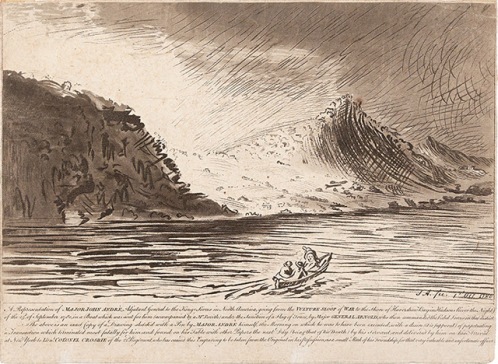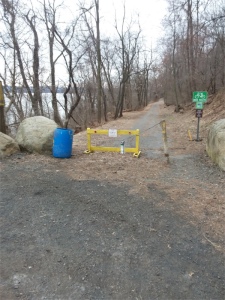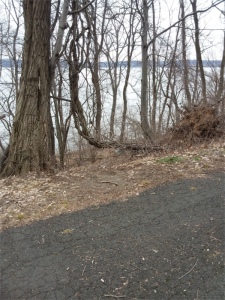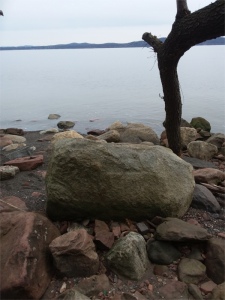
Although I grew up in the area I had never paid much attention to this part of American history. I therefore determined that, since I was once again in southern New York for a science fiction convention that I would go down a few days early to follow the path of Major John André, Adjutant-General to the British Army during the American Revolution.

Our first stop was the Treason Site, where Major André met with Lieutenant General Benedict Arnold. We drove up from Nyack, NY, under clouds that threatened rain, to Haverstraw, NY. There, in the woods that are now Haverstraw Beach State Park, André came ashore and met with Arnold. From Nyack you go north on Rt 9W (Not, as you might think, 9 West, but 9W. There are an awful lot of Route 9s in this part of New York; 9, 9A, 9B, 9C, etc. Perhaps more on this anon.) As you drive north, the view toward the Hudson to the east is of an entirely unprepossessing sand-and-gravel quarry. But a fish-hook loop on Short Clove Road, then back south, closer to the water on Riverside Avenue (a road not visible from the bluffs above where 9W runs) takes you to a small parking area with a barrier blocking off access to the road continuing south and signs warning, “Picknicking Beyond This Point Not Permitted,” “Park Closes at Dusk,” and “Only Hikers and Wide-Tire Bicycles Beyond This Point.”
So, we parked, and I hiked.
The historical marker is perhaps 600 feet down the path, on the left (east) side of the trail. It’s at 41° 10.683′ N, 73° 56.624′ W (41.1779, -73.9434). The sign is white-on-brown, and reads:

TREASON SITE
Within these woods, in the early morning hours of September 22, 1780, American General Benedict Arnold and British Major John André plotted the surrender of the American fortress at West Point. While attempting to return to British lines, André was captured by American soldiers. He was tried, convicted and hanged as a spy at Tappan on October 2, 1780. Traitor Arnold escaped and joined the British.

About thirty feet north of the marker there’s a small, unmarked trail leading off to the east, down toward the Hudson. It isn’t a very difficult trail to follow, though it would be challenging to someone with mobility issues. You can see the Hudson through the trees, and imagine His Majesty’s Sloop of War Vulture lying there, having delivered Major André, in full uniform, under flag of truce, to his meeting.
Originally the meeting was supposed to take place aboard Vulture, but Arnold was unwilling to go out, so André went ashore. Major André had been given three orders by his boss, General Sir Henry Clinton: Don’t go behind American lines. Don’t take off your uniform. And don’t carry any incriminating papers. The major had just disobeyed that first order. Within twenty-four hours he would disobey the other two … with unhappy results. But back to that trail… it leads down to the west bank of the Hudson River, and a stone. 41° 10.667′ N, 73° 56.582′ W (41.177783, -73.943033)


Carved into a boulder on the water’s edge we can read these words: ANDRE THE SPY LANDED HERE SEPT. 21, 1780.


From the back of the stone, looking across the Hudson, the east bank isn’t that far away. We can imagine HMS Vulture anchored there; in full view of the Revolutionary batteries at Teller’s Point. The Hudson is only about 1.5 miles wide here, and a cannon would have a range of about three miles. As dawn rose the Continentals took the British craft under fire, and Vulture retired down-river, stranding Major André.
About five feet north of the “André the Spy” stone someone had built a little structure of stones and sticks, to what purpose I do not know.
I climbed back up to the paved path, thinking of how John André must have felt, standing at the same place and watching his ride leave without him.
It’s a good thing for the United States that Major André was a desk jockey rather than an operator and that he had never gone to SERE School. But, still, at that moment, he sure had my sympathy. (I’m not alone in that: Major General Nathanael Greene., who headed up Major André’s court martial, the Marquis de Lafayette, who sat on that court martial board, and General George Washington, who signed Major André’s death warrant, all felt the utmost sympathy for him.)
So I saluted in the direction of the battery at Teller’s Point, and proceeded to the next stop on my André Tour.
[TO BE CONTINUED…]

Reblogged this on Dr. Doyle's Blog and commented:
From Jim Macdonald’s blog, the first stop on our Major Andre Historical Tour: